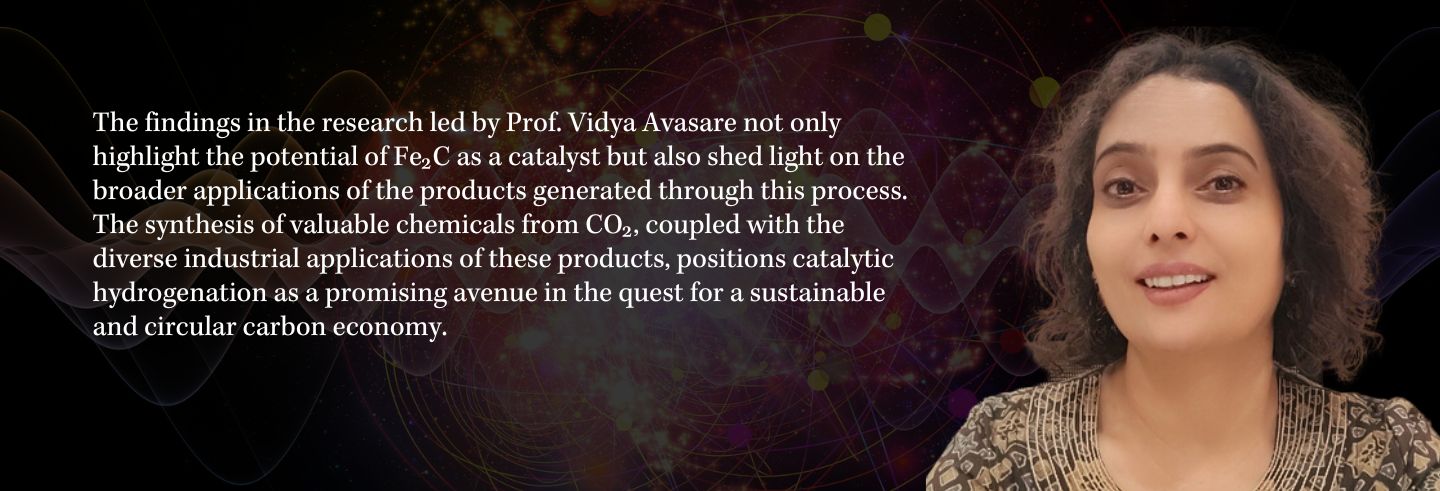Catalysing Sustainability: Magnetic Iron Carbide in Transforming CO₂ to Value-Added Products
This research, led by Prof Vidya Avasare, leverages the unique qualities of a catalyst to drive the conversion of CO₂ into valuable products
Over the last two and a half centuries, the Earth has witnessed a concerning surge in the concentration of carbon dioxide (CO2) in the atmosphere. A staggering increase of 143.5 parts per million (ppm) has been recorded, and what is even more alarming is that a significant portion of this rise—120 ppm, to be precise—has occurred in a mere forty-year span. This rapid escalation in CO2 levels poses a formidable threat to our global environment, necessitating urgent attention and proactive measures.
The urgency of addressing this issue is underscored by its significant impact on our planet. The rising levels of CO2 are a key driver of climate change, contributing to global warming and its associated consequences, such as more frequent and severe weather events, rising sea levels, and disruptions to ecosystems. In response to this looming crisis, the international community has come together under the umbrella of the Paris Climate Agreement, a landmark accord that outlines ambitious targets to mitigate climate change.
The Paris Climate Agreement aims to limit the global temperature increase to well below 2 degrees Celsius above pre-industrial levels, with efforts directed towards achieving a more stringent 1.5-degree Celsius target. Additionally, the agreement envisions a world that is carbon-neutral by 2050—a vision that requires a drastic reduction in greenhouse gas emissions, particularly CO2. While these goals are commendable and imperative for the survival of our planet, the path to achieving them is riddled with challenges.
A major hurdle in realising the objectives of the Paris Climate Agreement is the undeniable fact that essential human activities, particularly industrial processes, are significant contributors to CO2 emissions. These emissions result from the combustion of fossil fuels, industrial processes, and deforestation, among other human-induced activities. Tackling climate change, therefore, demands not only a reduction in these emissions but also innovative and sustainable solutions that allow for the continuation of essential industrial processes.
One such solution gaining attention is the onsite capture and conversion of CO2 into value-added products. This approach presents a unique opportunity to mitigate the environmental impact of CO2 emissions without compromising the ongoing industrial activities that fuel our economies. The use of catalysts in this process has shown promise, with heterogeneous catalysts, in particular, demonstrating commercial potential in various industrial applications.
This work, led by Vidya D. Avasare, Professor of Chemistry at Ashoka University, brings the focus to iron carbide (Fe2C). This catalyst is chosen for its distinctive qualities: sustainability, air stability, high magnetism, and cost-effectiveness. These attributes make iron carbide a compelling candidate for the hydrogenation of carbon dioxide—an essential step in converting CO2 into valuable products.
Researchers thoroughly examine the catalytic performance of iron carbide using the Density Functional Theory (DFT) method. This theoretical approach allows for a deep dive into the molecular-level interactions and reactions that take place during the hydrogenation of CO2. The results of these theoretical calculations paint a promising picture. Iron carbide emerges as an excellent catalyst, showcasing remarkable efficiency in converting CO2 into C1 products, including formic acid (HCOOH), formaldehyde (HCHO), methanol (CH3OH), and methane (CH4).
The significance of these C1 products extends beyond their role as by-products. Methanol and formic acid, in particular, emerge as promising materials for hydrogen storage in fuel cell applications. This opens up new avenues for the utilisation of the products generated through the hydrogenation of CO2, contributing to advancements in sustainable energy storage technologies.
Expanding the scope of their investigation, the researchers explore the catalytic capabilities of Fe2C in C—C cross-coupling reactions. These reactions involve the combination of formaldehyde with various alcohols, such as methanol, ethanol, and propanol, leading to the formation of ethanol, propanol, and butanol, respectively. This diversification of product outcomes showcases the versatility of Fe2C as a catalyst, with the potential to yield a range of valuable chemical compounds.
A notable finding in the study is the ease with which Fe2C (Iron Carbide, Catalyst) facilitates the dehydration reaction on its surface, transforming ethanol into ethylene. This opens up possibilities for synthesising higher derivatives of alkane, alkene, and alcohols from carbon dioxide. The ability to produce ethylene is particularly noteworthy, considering its significance in various industrial processes.
The broader implications of these findings are profound. The products obtained through the catalytic hydrogenation of carbon dioxide—methane, methanol, ethanol, propanol, butanol, and ethylene—hold significant applications across diverse industries. From pharmaceuticals to chemicals, polymers to textiles, and transportation, the potential impact on various sectors is substantial. That aligns with the overarching goal of creating a circular carbon economy—a system where carbon is continuously recycled, minimising waste and environmental impact.
In conclusion, the study on the catalytic performance of Fe2C in the hydrogenation of carbon dioxide represents a pivotal contribution to the ongoing efforts to address climate change. The findings not only highlight the potential of Fe2C as a catalyst but also shed light on the broader applications of the products generated through this process. The synthesis of valuable chemicals from CO2, coupled with the diverse industrial applications of these products, positions catalytic hydrogenation as a promising avenue in the quest for a sustainable and circular carbon economy. As we navigate the complexities of climate change, innovative solutions like these offer hope for a future where environmental sustainability and industrial progress can coexist harmoniously.
(Edited by Dr Yukti Arora)
Reference Article:
Assessment of the Catalytic Performance of a Heterogeneous Fe2C Catalyst in the Formation of Multicarbon Products from Carbon Dioxide, ACS Appl. Energy Mater. 2023, 6, 21, 10748–10760
Authors: Madhu Samolia and Vidya Avasare













